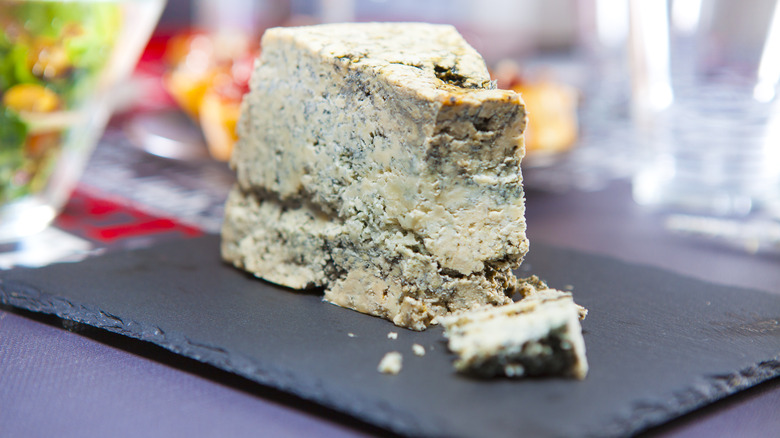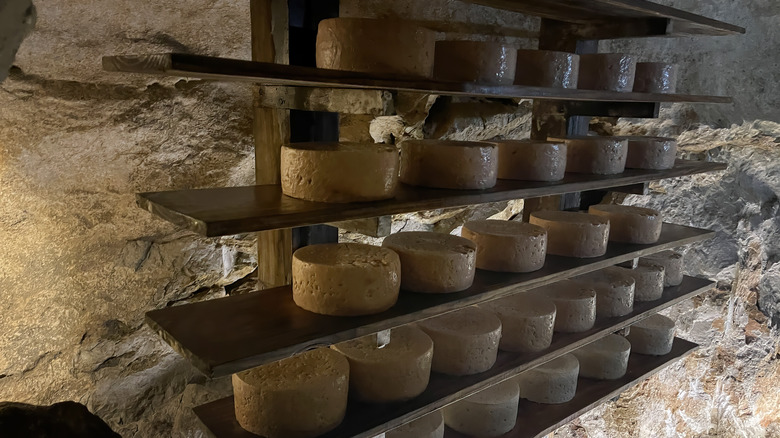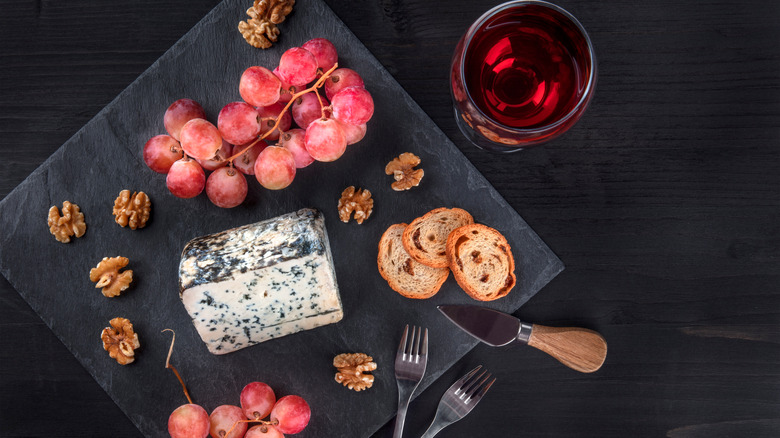The Most Expensive Cheese In The World Is Stored In Caves
Expensive food and drink can come in a variety of forms, drawing their extravagant value either from the complicated, often age-old traditional methods of making them or, as is the case with the world's most expensive ice cream, because of the costly ingredients used in them. The world's most expensive cheese, though, has a surprisingly rustic origin and was initially made by shepherds in the remote hilly province of Asturias in Northwestern Spain.
The famous Cabrales blue cheese currently holds the record for the world's most expensive cheese – a 2.2-kilogram wheel of the stuff recently fetched the eyewatering sum of 30,000 Euros at a local auction after winning the award for the best Cabrales, according to The Times. The firm and creamy blue-veined cheese is made using raw milk from cows, sheep, and goats and is aged in natural limestone mountain caves that provide very specific low-temperature and high-humidity conditions. Add to that an aging process that can last several months and the fact that the cheese is carried back on foot from the high-altitude caves once it has matured, and you have yourself some deliciously expensive Cabrales blue cheese.
What's so special about Cabrales cheese and its caves?
From as far back as the 18th century, Cabrales cheese has attracted foodies (though they probably weren't called that at the time) to the remote Asturias mountain province within the enormous Picos de Europa National Park in Northern Spain. An information document on the cheese from the Spanish Ministry of Agriculture explains that the cheese makes appearances in everything from the accounts of Spanish conquistadors and the diary of the Spanish 18th century Enlightenment thinker Gaspar Melchor de Jovellanos and in Madoz's Geographical Dictionary which describes the country's salient features during the 19th century.
One reason this cheese is special is because of its highly regulated region of production. As is the case with real Parmigiano Reggiano cheese, which is sometimes imprinted with dots as a sign of its authenticity, Cabrales comes with a similar Protected Designation of Origin or DOP insignia to prove that it has originated from a specific region and has passed all quality tests by local experts. Only milk from the cattle of this region is used, and after undergoing various coagulation, molding, salting, and resting processes for about 20 days, the cheese is placed in caves for maturation.
The caves themselves are a crucial part of the process, which inextricably links the cheese to the region's hilly landscape. These caves, generally at an altitude of 800 to 1,200 meters above sea level, offer a rare combination of very high humidity (over 90%) and low temperature that is conducive to the growth of the Penicillium-type molds that give the cheese its characteristic blue-green patches and veins. The company that made the 30,000-Euro wheel of Cabrales told The Times that the record-breaking cheese had matured in a cave at an altitude of 1,400 meters for at least eight months.
How does Cabrales cheese taste and how is it eaten?
Depending on the manufacturing process, Cabrales can have varying degrees of creaminess and sharpness. In general, it has a relatively firm texture but, due to its high fermentation, retains a creamy consistency. As expected with blue cheese, it has a strong characteristic aroma and a sharp, acidic, slightly salty taste. There are also some spicy notes in the cheese, which tend to be more prominent when a higher ratio of goat or sheep milk is used to make it.
Whilst eating a cheese, or any food of this caliber (and cost), you must pair it with fare that compliments its flavor and highlights its complexity. The sharp and salty Cabrales cheese is, therefore, often eaten alongside fruits like figs, red wine, salami, or sweet sherry. It can also be served with baguette slices and crackers for those who want to experience the flavor in isolation. However, as expensive as they may be, such ingredients are also incorporated into dishes, and Cabrales cheese is used as a base for sauces that will be enjoyed with various meats. In particular, you'll find this super fancy, super expensive cheese making its way from the mountain caves of Northern Spain to fancy restaurants to be served melted atop sirloin steaks.


